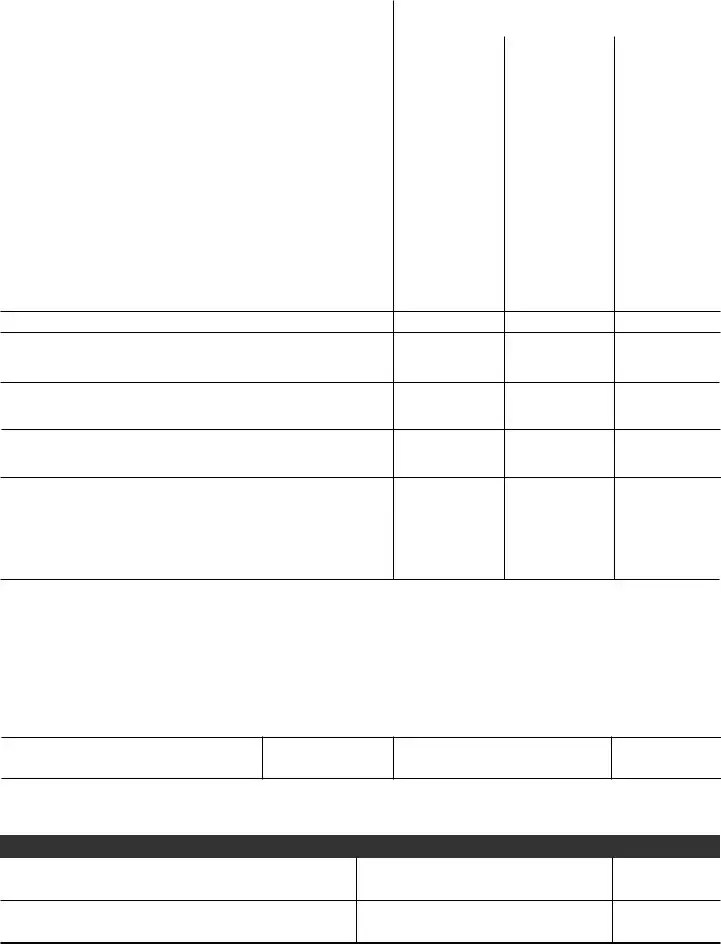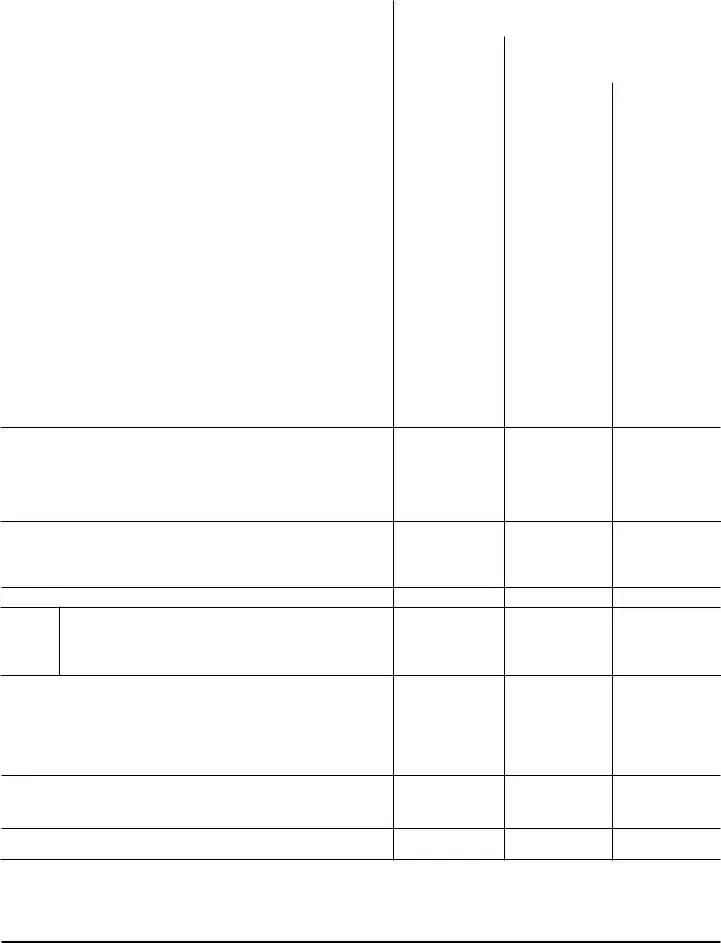Form 4549 |
|
Department of the Treasury-Internal Revenue Service |
|
|
|
|
|
|
|
|
|
Income Tax Examination Changes |
|
|
|
Page |
|
of |
|
|
(Rev. May 2008) |
|
|
|
|
|
|
|
|
|
|
|
|
|
|
|
|
|
|
|
|
|
|
Name and Address of Taxpayer |
|
Taxpayer Identification Number |
|
Return Form No.: |
Jack and Susan Anson |
|
XXX-XX-XXXX |
|
|
|
1040 |
|
|
|
|
|
|
|
|
|
|
|
|
|
|
|
|
|
Person with whom |
Name and Title: |
|
|
|
|
|
|
|
|
examination |
|
|
Jack and Susan Anson |
|
|
|
|
changes were |
|
|
|
|
|
|
|
|
|
|
|
|
discussed. |
|
|
|
|
|
|
|
|
1. |
Adjustments to Income |
|
Period End |
|
Period End |
Period End |
|
12-31-XX |
|
12-31-XX |
12-31-XX |
|
|
|
|
|
a. Itemized Deductions |
|
XXXXX |
|
|
XXXXX |
|
|
XXXXX |
b. Standard Deduction |
|
|
|
|
|
|
|
|
(XXXXX) |
c. |
|
|
|
|
|
|
|
|
|
|
|
|
d. |
|
|
|
|
|
|
|
|
|
|
|
|
e. |
|
|
|
|
|
|
|
|
|
|
|
|
f. |
|
|
|
|
|
|
|
|
|
|
|
|
g. |
|
|
|
|
|
|
|
|
|
|
|
|
h. |
|
|
|
|
|
|
|
|
|
|
|
|
i. |
|
|
|
|
|
|
|
|
|
|
|
|
j. |
|
|
|
|
|
|
|
|
|
|
|
|
k. |
|
|
|
|
|
|
|
|
|
|
|
|
l. |
|
|
|
|
|
|
|
|
|
|
|
|
m. |
|
|
|
|
|
|
|
|
|
|
|
|
n. |
|
|
|
|
|
|
|
|
|
|
|
|
o. |
|
|
|
|
|
|
|
|
|
|
|
|
p. |
|
|
|
|
|
|
|
|
|
|
|
|
|
|
|
|
|
|
|
|
|
|
|
2. |
Total Adjustments |
|
XXXXX |
|
|
XXXXX |
|
|
XXXX |
3.Taxable Income Per Return or as Previously Adjusted
4.Corrected Taxable Income
Tax Method |
Tax Table |
Tax Table |
Tax Table |
Filing Status |
Joint |
Joint |
Joint |
5.Tax
6.Additional Taxes / Alternative Minimum Tax
7.Corrected Tax Liability
8.Less a. Credits b. c. d.
9.Balance (Line 7 less Lines 8a through 8d)
10.Plus a. Other b. Taxes c. d.
11.Total Corrected Tax Liability (Line 9 plus Lines 10a through 10d)
12.Total Tax Shown on Return or as Previously Adjusted
13.Adjustments to: a.
b.
c.
14.Deficiency-Increase in Tax or (OverassessmentDecrease in Tax) (Line 11 less Line 12 adjusted by Lines 13a through 13c)
15.Adjustments to Prepayment Credits - Increase (Decrease)
16.Balance Due or (Overpayment) - (Line 14 adjusted by Line 15)
(Excluding interest and penalties) |
XXXX.XX |
XXXX.XX |
XXX.XX |
The Internal Revenue Service has agreements with state tax agencies under which information about federal tax, including increases or decreases, is exchanged with the states. If this change affects the amount of your state income tax, you should amend your state return by filing the necessary forms.
You may be subject to backup withholding if you underreport your interest, dividend, or patronage dividend income you earned and do not pay the required tax. The IRS may order backup withholding (withholding of a percentage of your dividend and/or interest income) if the tax remains unpaid after it has been assessed and four notices have been issued to you over a 120-day period.
Catalog Number 23105A |
www.irs.gov |
Form 4549 (Rev. 5-2008) |

Form 4549 |
|
|
Department of the Treasury-Internal Revenue Service |
|
|
|
|
|
|
|
|
|
Income Tax Examination Changes |
|
|
Page |
|
of |
|
|
|
(Rev. May 2008) |
|
|
|
|
|
|
|
|
|
|
|
|
|
|
|
|
|
|
|
|
|
|
|
Name of Taxpayer |
|
Taxpayer Identification Number |
|
Return Form No.: |
|
Jack and Susan Anson |
|
XXX-XX-XXXX |
|
|
|
1040 |
|
|
|
|
|
|
|
|
|
|
|
|
|
|
|
|
|
|
|
|
|
|
|
|
|
|
Period End |
Period End |
Period End |
|
17. Penalties/ Code Sections |
|
12-31-XX |
12-31-XX |
12-31-XX |
|
a. Accuracy Related Penalty - IRC 6662 |
XXX.XX |
|
XXX.XX |
|
|
XX.XX |
|
b. |
|
|
|
|
|
|
|
|
|
|
c. |
|
|
|
|
|
|
|
|
|
|
d. |
|
|
|
|
|
|
|
|
|
|
e. |
|
|
|
|
|
|
|
|
|
|
f. |
|
|
|
|
|
|
|
|
|
|
g. |
|
|
|
|
|
|
|
|
|
|
h. |
|
|
|
|
|
|
|
|
|
|
i. |
|
|
|
|
|
|
|
|
|
|
j. |
|
|
|
|
|
|
|
|
|
|
k. |
|
|
|
|
|
|
|
|
|
|
l. |
|
|
|
|
|
|
|
|
|
|
m. |
|
|
|
|
|
|
|
|
|
|
n. |
|
|
|
|
|
|
|
|
|
|
18.Total Penalties
Underpayment attributable to negligence: (19811987) A tax addition of 50 percent of the interest due on the underpayment will accrue until it is paid or assessed.
Underpayment attributable to fraud: (19811987)
A tax addition of 50 percent of the interest due on the underpayment will accrue until it is paid or assessed.
Underpayment attributable to Tax Motivated Transactions (TMT). The interest will accrue and be assessed at 120% of the under payment rate in accordance with IRC §6621(c)
19.Summary of Taxes, Penalties and Interest:
a. |
Balance due or (Overpayment) Taxes - (Line 16, Page 1) |
XXXX.XX |
XXXX.XX |
XXX.XX |
b. |
Penalties (Line 18) - computed to |
|
XXX.XX |
XXX.XX |
XX.XX |
c. |
Interest (IRC § 6601) - computed to |
|
XXX.XX |
XXX.XX |
XX.XX |
d. |
TMT Interest - computed to |
(on TMT underpayment) |
|
|
|
e. |
Amount due or (refund) (sum of Lines a, b, c and d) |
XXXX.XX |
XXXX.XX |
XXXX.XX |
Other Information:
Consent to Assessment and Collection- I do not wish to exercise my appeal rights with the Internal Revenue Service or to contest in the United States Tax Court the findings in this report. Therefore, I give my consent to the immediate assessment and collection of any increase in tax and penalties, and accept any decrease in tax and penalties shown above, plus additional interest as provided by law. It is understood that this report is subject to acceptance by the Area Director, Area Manager, Specialty Tax Program Chief, or Director of Field Operations.
PLEASE NOTE: If a joint return was filed. BOTH taxpayers must sign
Signature of Taxpayer |
Date: |
Signature of Taxpayer |
|
|
|
Catalog Number 23105A |
www.irs.gov |
Form 4549 (Rev. 5-2008) |


